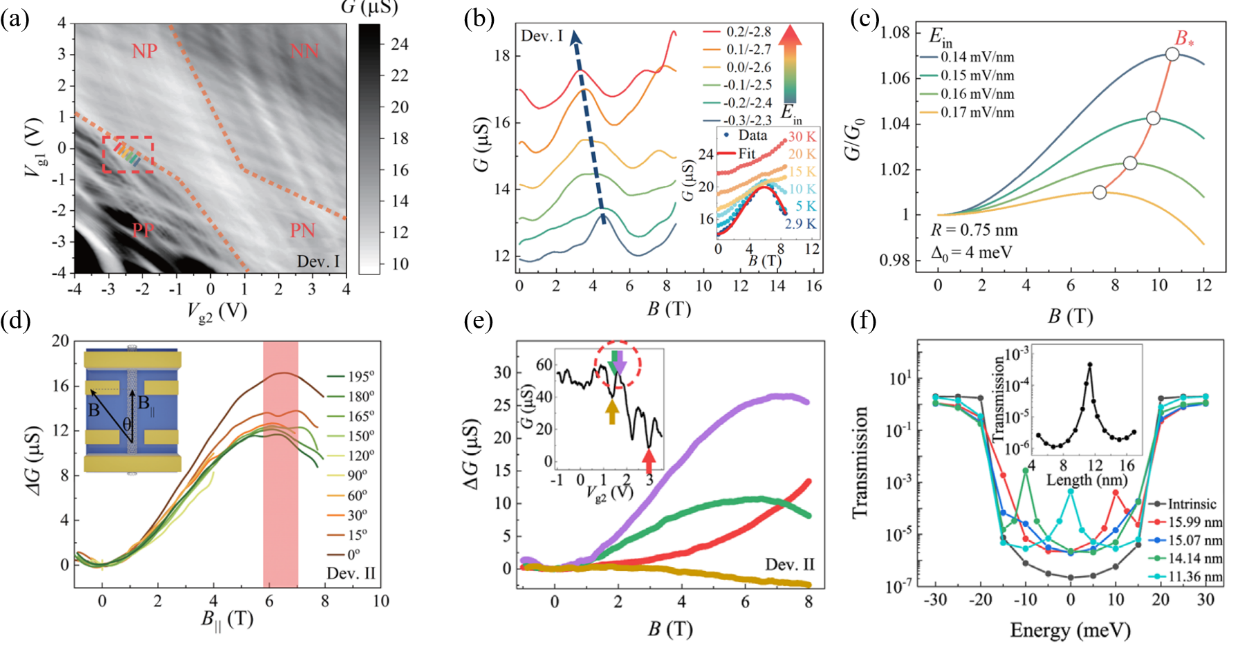As an optimal low-dimension electronic system, carbon nanotubes (CNTs) have specific electronic structures and properties, and exhibit excellent quantum properties. It offers an attractive platform to develope integrated circuits and quantum computing devices. Carbon nanotubes are tubular one-dimensional materials composed of carbon atoms, which provide an ideal experimental platform to study the Aharonov-Bohm (AB) effect under coaxial magnetic fields. However, due to its ultra-small diameter, achieving a flux quantum in a carbon tube requires an ultra-high magnetic field (10 nm diameter requires about 50 T axial magnetic field), which greatly limits experimental observations and studies. Earlier experimental studies observed AB oscillations by using multilayer carbon nanotubes with large tube diameters to reduce the magnetic field required for flux quanta, or by using potential tunneling through the Schottky barriers (SBs) formed at the interface between carbon nanotubes and electrodes, but all of them were difficult to overcome the difficulties such as the disorder of the system intrinsic and the fixed tunneling barrier, thus lacking stable and controllable means to study the AB effect in the one-dimensional system. In 2004, Andreev theoretically proposed that the observation of flux-modulated quantum interference effects at low fields might be achieved by combining Landau-Zener tunneling with AB effects using the characteristic structure of p-n junctions (Phys. Rev. Lett. 2007, 99, 247204). Due to the difficulty of regulating the device, however, it has not been implemented experimentally.
Zhiyong Zhang and Ning Kang from the Key Laboratory for the Physics and Chemistry of Nanodevices and Center for Carbon-based Electronics of School of Electronics at Peking University, cooperate with Yin Wang from Hongzhiwei Technology (Shanghai) Co., Ltd. and Kaili Jiang from Department of Physics and Tsinghua Foxconn Nanotechnology Research Center of Tsinghua University. This joint research team has made advancement in the direction of quantum coherent transport research in carbon nanotubes: the first quantum interference effect with built-in electric field modulation was achieved, and further Fabry-Perot (FP) interference-enhanced AB effect was observed in the low magnetic field region. Theteam achieved effective regulation of the strength of single carbon nanotube p-n junctions by constructing paired side gate structures on the sheet, and obtained high-quality carbon nanotube devices operating in the ballistic transport interval (Fig. 1). The experiments were performed by stabilizing the device operating interval at the p-n boundary in the double-gate spectrum. The characteristic nonmonotonic magnetic transport behavior is successfully observed in the direction of the enhancement along the built-in electric field, in coherence with the image predicted by simulation theory (Fig. 2a-c). The evolution of magnetotransport behavior at low temperatures and different tilt angles further verifies the AB origin of magnetic conductivity (Fig. 2b & Fig. 2d). The nonmonotonic magnetoconductance response is enhanced due to the presence of Fabry-Pérot resonances (Fig. 2e). Calculations based on the non-equilibrium Greens function approach and the density functional theory (NEGF-DFT) further show the behavior of the transmission coefficient for resonance modulation (Fig. 2f). This research provides a new scheme for the study of quantum interference effects in the one-dimensional electronic system and the development of multi-field modulation tools.
On May 17th, the joint research team published a research paper entitled“Gate-Controlled Quantum Interference Effects in a Clean Single-Wall Carbon Nanotube p-n Junction”on Physical Review Letters. School of Electronics doctoral student Xiaosong Deng is the first author, while Research Professor Ning Kang and Professor Zhiyong Zhang are the co-corresponding authors. This research was supported by the National Natural Science Foundation of China, the Innovation Program for Quantum Science and Technology, the China Postdoctoral Science Foundation, and the PKU Nanofab Cleanroom.
To access the full paper, please visit: https://link.aps.org/doi/10.1103/PhysRevLett.130.207002

Fig 1. A double split-gate structure p−n junction based on single-wall carbon nanotube.

Fig 2. Built-in electric field modulation, and Fabry-Perot interference-enhanced AB magnetoconductance oscillations.




